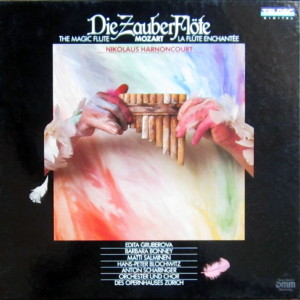 |
2 LP -
6.35766 EX - (p) 1988
|

|
| 2 CD -
8.35766 ZA - (p) 1988 |
|
Wolfgang
Amadeus Mozart (1756-1791)
|
|
|
|
|
|
|
|
| Die Zauberflöte, KV 620 |
|
|
|
| Eine Große Oper in zwei Akten -
Dichtung von Emanuel Schikaneder |
|
|
|
|
|
|
|
| Ouverture |
|
6' 26" |
A1 |
| Erster Aufzug |
|
59' 39" |
|
| - No. 1 - Introduction: "Zu
Hilfe! zu Hilfe! sonst bin ich verloren" -
(Drei Damen, Tamino) |
6' 34" |
|
A2 |
| - Zwischentext |
0' 30" |
|
A3 |
| - No. 2 - Aria: "Der Vogelfänger
bin ich ja" - (Papageno) |
3' 00" |
|
A4 |
| - Zwischentext |
0' 58" |
|
A5 |
| - No. 3 - Aria: "Dies Bildnis
ist bezaubernd schön" - (Tamino) |
4' 02" |
|
A6 |
| - Zwischentext |
0' 25" |
|
A7 |
| - No. 4 - Recitativo ed Aria: "O
Zittre nicht, mein lieber Sohn" - (Königin
der Nacht) |
4' 36" |
|
A8 |
| - Zwischentext |
0' 07" |
|
A9 |
| - No. 5 - Quintetto: "Hm! hm!
hm!" - (Drei Damen, Tamino, Papageno) |
6' 36" |
|
A10 |
| - Zwischentext |
0' 22" |
|
A11 |
| - No. 6 - Terzetto: "Du feines
Täubchen" - (Pamina, Monostatos, Papageno) |
1' 36" |
|
A12 |
| - Zwischentext |
1' 07" |
|
A13 |
| - No. 7 - Duetto: "Bei Männern,
welche Liebe fühlen" - (Pamina, Papageno) |
4' 20" |
|
B1 |
| - Zwischentext |
0' 07" |
|
B2 |
| - No. 8 - Finale: "Zum Ziele
führt dich diese Bahn" - (Pamina, Drei
Knaben, Tamino, Monostatos, Sarastro,
Sprecher, Papageno, Chor) |
24' 48" |
|
B3 |
| Zweiter Aufzug |
|
77' 38" |
|
| - No. 9 - Marcia |
2' 52" |
|
B4 |
| - Zwischentext |
1' 27" |
|
B5 |
| - No. 10 - Aria con Coro: "O
Isis und Osiris" - (Sarastro, Chor) |
2' 53" |
|
B6 |
| - Zwischentext |
1' 27" |
|
C1 |
| - No. 11 - Duetto: "Bewahret
euch vor Weibertücken" - (Zweiter
Priester, Sprecher) |
0' 55" |
|
C2 |
| - Zwischentext |
0' 19" |
|
C3 |
| - No. 12 - Quintetto: "Wie? wie?
wie? ihr an diesem Schreckensort?" - (Drei
Damen, Tamino, Papageno) |
3' 09" |
|
C4 |
| - Zwischentext |
0' 41" |
|
C5 |
| - No. 13 - Aria: "Alles fühlt
der Liebe Freuden" - (Monostatos) |
1' 14" |
|
C6 |
| - Zwischentext |
0' 45" |
|
C7 |
| - No. 14 - Aria: "Der Hölle
Rache kocht in meinem Herzen" - (Königin
der Nacht) |
3' 00" |
|
C8 |
| - Zwischentext |
0' 40" |
|
C9 |
| - No. 15 - Aria: "In diesen
heil'gen Hallen kennt man die Rache
nicht!" - (Sarastro) |
4' 03" |
|
C10 |
| - Zwischentext |
0' 55" |
|
C11 |
| - No. 16 - Terzetto: "Seid uns
zum zweiten Mal willkommen" - (Drei
Knaben) |
1' 24" |
|
C12 |
| - Zwischentext |
1' 09" |
|
C13 |
| - No. 17 - Aria: "Ach Ich
fühl's, es ist verschwunden!" - (Pamina) |
4' 02" |
|
C14 |
| - Zwischentext |
0' 37" |
|
C15 |
| - No. 18 - Chor der Priester: "O
Isis, und Osiris, welche Wonne!" |
2' 57" |
|
C16 |
| - Zwischentext |
0' 32" |
|
C17 |
| - No. 19 - Terzetto: "Soll ich
dich Teuer nicht mehr sehn?" - (Pamina,
Tamino, Sarastro) |
3' 41" |
|
C18 |
| - Zwischentext |
1' 11" |
|
C19 |
| - No. 20 - Aria: "Ein Mädchen
oder Weibchen Wünscht Papageno sich!" -
(Papageno) |
1' 35" |
|
D1 |
| - Zwischentext |
1' 03" |
|
D2 |
| - No. 21 - Finale: "Bald prangt,
den Morgen zu verkünden": |
31' 45" |
|
D3 |
| (Königin der Nacht, Pamina,
Papagena, Drei Knaben, Drei Damen, Tamino,
Monostatos, Erster und zweiter
geharnischter Mann, Sarastro, Papageno,
Chor) |
|
|
|
|
|
|
|
| Matti
Salminen, Sarastro |
Anton
Scharinger, Papageno |
|
| Hans-Peter
Blockwitz, Tamino |
Edith
Schmid, Papagena |
|
Thomas
Hampson, Sprecher
|
Peter
Keller, Monostatos |
|
Alexander
Maly, Erster Priester
|
Stefan
Gienger, Knabe |
|
| Waldemar
Kmentt, Zweiter Priester |
Markus
Baur, Knabe |
|
| Edita
Gruberova, Königin der
Nacht |
Andreas
Fischer, Knabe |
|
| Barbara
Bonney, Pamina |
Thomas
Moser, Erster Gehamischter |
|
| Pamela
Coburn, Erste Dame |
Antti
Suhonen, Zweiter
Gehamischter |
|
| Delores
Ziegler, Zweiter Dame |
Gertraud
Jesserer, Zwischentext |
|
| Marjana
Lipovšek, Dritte Dame |
|
|
|
|
| Chor des Opernhauses Zürich
/ Erich Widl, Einstudierung |
|
| Orchester des Opernhauses
Zürich |
|
|
|
| Nikolaus
Harnoncourt, Dirigent |
|
|
Luogo e data
di registrazione
|
| Kirche
Altstetten, Zurigo
(Svizzera) - novembre 1987 |
|
Registrazione
live / studio
|
| studio |
Producer / Engineer
|
Wolfgang Mohr / Michael
Brammann
|
Prima Edizione
CD
|
Teldec - 8.35766 ZA - (2 cd) -
73' 17" + 70' 26" - (p) 1988 - DDD
|
Prima
Edizione LP
|
Teldec - 6.35766 EX - (2 lp) -
73' 17" + 70' 26" - (p) 1988 - Digital
|
|
|
Nikolaus
Harnoncourt: A Family Drama
|
In the
Magic Flute there is a celebrated
“break” at the point where -
apparently without warning - the
“good” Queen of the Night suddenly
becomes "evil", where the “evil”
Sarastro becomes “good", and where the
three boys change sides; they were,
after all, provided by the Queen as
guides for the two wanderers - now we
suddenly find them in Sarastro’s camp,
giving warnings and advice. The
literature on Mozart has
for nearly 200 years been
providing innumerable explanations for
this “break". It is
suggested that the radical
reconstruction of the plot occured in
the middle of the composition of the
work because another magic opera on a
similar subiect had just appeared, or
in order to lay stress on the rites
and ideals of Freemasonry etc. All
these hypotheses are based on the
assumption that such a break exists. My
view, however, is that there is no
reason to assume - particularly with
such fairy-tale material - that such a
mistake was made. To alter the concept
without reconstructing the part which
had already been written would really
have been an incomprehensible mistake,
although in a Viennese work of this
type one cannot expect strict
consistency or realistic logic.
I am reminded of the
time when friends of ours were getting
a divorce: During the morning the
husband visited us and explained
everything from his standpoint; we
understood his point of view and were
ready to condemn his wife as his
antagonist. In
the afternoon we were visited by the
wife and we succumbed also to her
arguments: now we considered the guilt
to be his alone, he was at fault. That
is exactly what happens to Tamino in
the Magic Flute.
One can imagine the background to the
story as being that of a mighty,
mysterious family with strange castles
and fortresses, ruling with a great
following and retinue both day and
night and a whole fairytale world.
Sarastro may well have been an
interesting friend of the family with
his own power base in the exclusive
men's club of 'initiates' and with
eccentric hobbies, such as going out
hunting every day in a chariot drawn
by lions or, when the fancy took him,
turning himself into an animal. His
later contempt for women may have been
attributable to the fact that he was
attracted to the lady of the house -
the Queen of the Night - or perhaps
that she was attracted to him;
whatever the circumstances, the
’affair’ ended in hatred and jealousy.
On the death of the old 'King’ his
dominions were broken up, the Queen
inheriting everything
except power over the clay, the
‘all-consuming’ orb of the sun. The
old man had left this lo Sarastro, the
friend of the family, who may well
also have had an eye on their little daughter
Pamina, as was to
appear later on. - The property, the
entourage, (the boys, the ladies the
slaves lions etc.) and the fortresses
were all divided up more or less
clearly ,but in such a way that an
exchange, a transfer of allegiance to
the other camp, was possible without too
much trouble. The
original
community of interest is still clearly
apparent on each side. -
In the end Sarastro abducted Pamina,
ostensibly to remove her from the evil
influence of her mother, but the fact
that he was in love with her is likely
also have played its part.
Tamino bursts in upon this domestic
drama and since he first hears the
story from the lips of the Queen, he
initially becomes her dedicated
supporter and an opponent of Sarastro.
But when he enters his territory and
there hears the arguments of the other
party, he allows himself to be
persuaded of their validity and to be
’converted’. The widely quoted break
is, therefore,
nothing other than the subtle
protrayal of a common human pattern of
thought and behaviour.
Neither of the two groups emerges
morally blameless from the affair.
Just as in human relationships love
very easily turns to hate, so it is
here: the Queen has a mortal hatred
for Sarastro and his
adherents, and she has certainly been
badly treated. - Although Sarastro
surrouds himself with an aura of love
and wisdom, in his domain there are
slaves, fetters, punishment and a
truly rnurderous lecher. The fate of
his prisoners is terrible; they are 'impaled
or hanged'; 'their deaths would
involve appalling torture’; the
ordeals are said to be so severe that
not every aspirant survives them.
Threats of these dangers are quite
cynically employed. Pamina is told to
bid her beloved 'a last farewell'.
Sarastro is, therefore, by no means so
virtuous and devoted to truth:
although he solemnly sings of his love
for humanity and abjures
all thought of revenge, he has
Monostatos flogged and destroys the
Queen of the Night and her followers.
Indeed, he obviously
lies on one occasion, when he says
'that is the reason why I took her (Pamina)
by force from her proud mother’,
implying that he did it in order to
bring her and Tamino together - in
fact he abducted Pamina because he
wanted her for himself. 'I do not wish
to force love upon you... you greatly
love another'.
Neither does Sarastro's intense
passion for hunting fit in very well
with the picture of the sage who
lovingly protects all forms of life. -
The only representative of perfection
in this fairy-tale,
in which women are so reviled, is the
girl Pamina.
Nikolaus
Harnoncourt
|
|
Nikolaus
Harnoncourt (1929-2016)
|

|

|
|